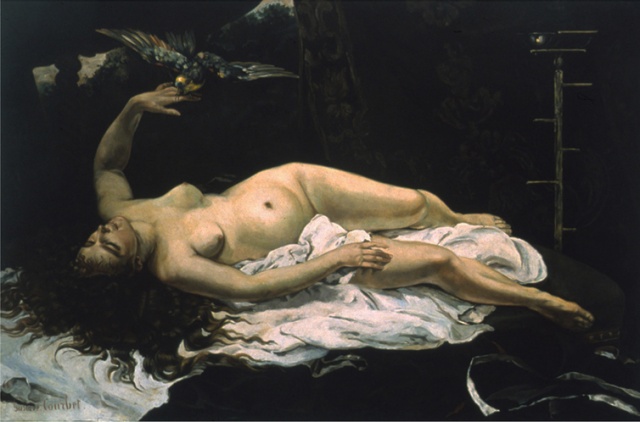Installations
A recent re-examination of Gustave Courbet’s Woman with a Parrot sheds important light on what Michael Fried has referred to as Courbet’s struggle with his own spectatorship; as well as what Fried and other critics have called a the “strange emptiness” of the right half of the painting, and the alien quality of the parrot stand.
The results of an X-ray as well as a pentimento uncovered by a recent cleaning, show that filling the “strange emptiness” is the nude figure of a young male.
This remarkable presence not only resolves the nagging problem of the painting’s composition, but also the problem that has plagued viewers as to the orientation of model and painter, Fried insisting that Courbet could now have painted the woman’s face without himself having approximated the position of the newly revealed figure.
Certainly the figure is Courbet, notorious in his youth for being not only extraordinarily handsome, but painting himself into his pictures. (In the case of the Portrait of the Artist of 1844-54, Courbet paints himself embracing a woman he subsequently painted out.)
Whether he painted himself into Woman with a Parrot in the effort to undo his own spectatorship, almost palpable in such earlier works as, for example, The Young Ladies on the Banks of the Seine of 1856-57; or, in a kind of reverse Pygmalionist gesture, painted himself onto the canvas in order to “literally” possess what his desire had made too real to resist. And, whether Courbet realized this strategy merely redoubles the effect of the possessive male gaze, or only that he had… gone too far; the fact is that, having put himself into the painting, Courbet… took himself out.
The hole this left had to be filled. In a countervailing act of self-abnegation, Courbet replaced the portrait of himself- an embodiment of youthful virility--- with … the portrait of a stick. The phallus stands, but desiccated, withered, as if to atone for the imperium of a gaze the painter finds it, finally, impossible to shake. The restored painting testifies nevertheless to the extent to which even the most conventional appearing of Courbet’s nudes is scarred by the painter’s struggle with that most fundamental of painterly problems, the very act of beholding itself.
